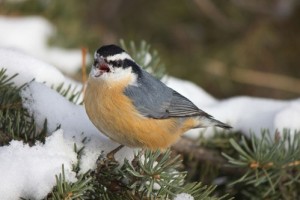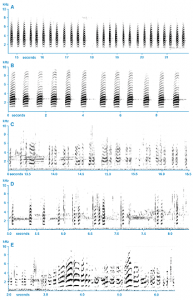A Little Background:
The Red-Breasted Nuthatch (Sitta canadensis) is a small bird with a compact body, a short neck and tail, and a long beak that is tapered. They are the only nuthatch in North America that has a broad black stripe over their eye, with a white stripe. They are in the order Passeriforme, which are perching birds. Perching birds are unique in the foot structure that allows them to grip thin branches, and twigs with ease. It even allows some species, like the red-breasted nuthatch, to grip vertical surfaces with ease. Further, Passeriformes are unique their ability to produce complex song, whether it is learned (oscines) or innate (suboscine). Most perching birds form monogamous pair bonds during the breeding season, in which they establish a territory where they build a nest and raise their young. Passerines provide their young with a good deal of parental care as chicks hatch blind and without feathers, or completely helpless. This is was just a recap as I will be focusing on its communication, song style, and song-learning.
Song Style/Structure:
The main song of the red-breasted nuthatch is made up of a series of short, nasally notes that sound like yank-yank. Each song generally has about six or more of these notes , which can be repeated up to sixteen times per minute. These songs are sung by unmated male birds mainly, but other males and females can also sing it. The same song is also sometimes sung at a slower pace and more harshly to defend territory. Sometimes brief versions of the song are sung during flight. The yank note can also be used as a call by male and female birds (though more often by the male) as a way of communicating between the pair. This note is often sped up until it sounds like a vibrating trill, typically given from near the nest just at the end of nest excavation or beginning of egg-laying. The sound of a yank note can be likened to a cartoon-like honking noise or even a trumpet. During a confrontation, a chase, or copulation, nuthatches may make a phew call, a call not Agitated birds sometimes make a wrenlike scolding call, while flicking their wings quickly. This call is a fast succession of raspy sounding notes, one after another. It is important to make note that overall the calls of the red-breasted nuthatch are quite quiet in comparison to other birds in the same habitat. Yet, categorizing the large array of sounds red-breasted nuthatches make can prove to be quite difficult. For example, with a simple yank yank depending on the context and speed at which it is delivered can greatly change the meaning. In spite of this many songs can still be placed into overall categories.
The most prominent of these is the courtship song, a repeated series of nasal yank-yank-yank. It may be 2–6 notes in a series, with 12–16 series sung/min, and may be repeated in very rapid succession, or delivered much more slowly. When males sing the courtship song with high intensity, it is often accompanied by a Singing-Male Courtship Pose , and this appears to be the common song given by unmated males on breeding grounds to attract females. Also, this song may vary in length, and sometimes is drawn out into long whine. Another song is the agonistic song, a quick, harsh series of hn-hn-hn notes, which at high intensity can be prolonged into electric buzzing sound. This is the most frequently heard vocalization of males during breeding season and is often accompanied by Aggressive-Male Courtship Pose, although females can also give this call. The agonistic song occurs more in territorial interactions, although it is difficult to distinguish between agonistic song and courtship song in both sound and function. Throughout breeding season, males commonly take part in countersinging with neighboring males and give the agonistic song. In actual conflicts, both males and females also give hard grr or chirr note.
There is also the contact call, which are low twitterings and medleys of notes used are produced quickly and with much variation. These can be seen as a type of “musical song”; a short, faint note, suggested by the whispered word “hit.” It is produced throughout the year for differing reasons. For example, males and females respond to each other’s contact calls during incubation when female is off the nest and both sexes are foraging together. And in nonbreeding season, contact calls are frequent when foraging in among different species. As mentioned before the red-breasted nuthatch also make phew calls. These notes a done one at a time or in short successions. Almost identical to phee-oonote of White-breasted Nuthatch, they are produced during conditions of “emotional intensity,” such as chases and copulation. Unlike White-breasted Nuthatch, Red-breasted Nuthatch may connect phew calls into a phrase of phew, phew, phew-phew-phew. Finally there are the food solicitation and agitation calls. The food solicitation call is produced by females being fed males during courtship and fledglings being fed by parents. It sounds like a serious of we-we notes akin to begging.
As mentioned previously, the red-breasted nuthatch’s songs tend to have a nasally quality in its production. This is a unique quality, as nasality is a component of birds sounds that are tonally complex, meaning the bird is producing several sounds at once, but we register those sounds as one note. On a spectrogram these sounds appear to be several copies stacked on an original note, these are called partials because they partial components of the sound. Nasality, however, can be difficult to interpret on a spectrogram because not every sound with partials has a nasal quality. Often this is because the fundamental note is dominant – nasality is determined by the frequency of the loudest partials, so when higher frequency partials are louder the tone is more nasal. The higher the pitch though the less overall nasal a tone will sound, this is because the partials are more widely spaced. Often birds that produce nasally sounds also have calls that have voice breaks in which birds jump to a higher pitch in a call or song and period doubling, when the notes have the quality of subharmonics, or extra partials that cause a hoarseness in the tone.
Song Mechanics:
As a Passeriforme, the red-breasted nuthatch is an oscine bird meaning that its song is learned. With oscines, there is generally a ‘sensitive learning’ period of time in a bird’s adolescence when the individual is better equipped for learning its tutor’s song. After this period it becomes very difficult to learn the tutor’s song or any song. More specifically, in oscine birds a young male bird learns the song of adult conspecific birds, as a mechanism to ensure that they are learning the appropriate tutor’s song. Laboratory studies may have shown the existence of an innate auditory template facilitating the recognition and memorization of conspecific song. However, there is little to no evidence about heterospecific learning and the red-breasted nuthatch, so it is unknown. Interestingly enough there is very little to be seen on the effects of cross-fostering on the red-breasted nuthatch song. Further, song learning seems to share characteristics with sexual imprinting. This means that just as sexual imprinting is learned preferences at young age, that song production, as in the song produced, is also a learned a preference. There are no dialects among the different populations of red-breasted nuthatches, and don’t have a large repertoire of songs to choose from. This suggests that they are indeed not open-ended learners of song, but rather close-ended learners.
Examples of Song:
Citations:
Ghalambor, Cameron K. and Thomas E. Martin. 1999. Red-breasted Nuthatch (Sitta canadensis), The Birds of North America Online (A. Poole, Ed.). Ithaca: Cornell Lab of Ornithology; Retrieved from the Birds of North America Online: http://bna.birds.cornell.edu/bna/species/459
Eriksen A, Slagsvold T. Mother-mediated tutor choice – an experimental study on song acquisition in wild great tits. Manuscript.
Klappenbach, Laura. Perching birds. About Education. Retrieved from About.com: http://animals.about.com/od/perching-birds/p/perching-birds.htm
Pieplow, Nathan. 2009. Nasality. Earbirding.com. Retrieved from Earbirding.com: http://earbirding.com/blog/specs/nasality
Red-breasted Nuthatch Fast Call – YouTube


